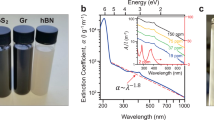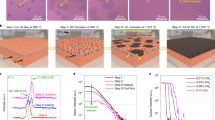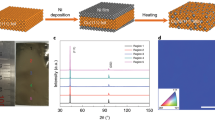Abstract
Bilayer and trilayer graphene with controlled stacking is emerging as one of the most promising candidates for post-silicon nanoelectronics. However, it is not yet possible to produce large quantities of bilayer or trilayer graphene with controlled stacking, as is required for many applications. Here, we demonstrate a solution-phase technique for the production of large-area, bilayer or trilayer graphene from graphite, with controlled stacking. The ionic compounds iodine chloride (ICl) or iodine bromide (IBr) intercalate the graphite starting material at every second or third layer, creating second- or third-stage controlled graphite intercolation compounds, respectively. The resulting solution dispersions are specifically enriched with bilayer or trilayer graphene, respectively. Because the process requires only mild sonication, it produces graphene flakes with areas as large as 50 µm2. Moreover, the electronic properties of the flakes are superior to those achieved with other solution-based methods; for example, unannealed samples have resistivities as low as ∼1 kΩ and hole mobilities as high as ∼400 cm2 V–1 s–1. The solution-based process is expected to allow high-throughput production, functionalization, and the transfer of samples to arbitrary substrates.
This is a preview of subscription content, access via your institution
Access options
Subscribe to this journal
Receive 12 print issues and online access
$259.00 per year
only $21.58 per issue
Buy this article
- Purchase on Springer Link
- Instant access to full article PDF
Prices may be subject to local taxes which are calculated during checkout





Similar content being viewed by others
References
Geim, A. K. & Novoselov, K. S. The rise of graphene. Nature Mater. 6, 183–191 (2007).
Ohta, T. et al. Controlling the electronic structure of bilayer graphene. Science 313, 951–954 (2006).
Zhang, Y. B. et al. Direct observation of a widely tunable bandgap in bilayer graphene. Nature 459, 820–823 (2009).
Craciun, M. F. et al. Trilayer graphene is a semimetal with a gate-tunable band overlap. Nature Nanotech. 4, 383–388 (2009).
Zhou, S. Y. et al. Substrate-induced bandgap opening in epitaxial graphene. Nature Mater. 6, 916–916 (2007).
Novoselov, K. S. et al. Two-dimensional atomic crystals. Proc. Natl Acad. Sci. USA 102, 10451–10453 (2005).
Berger, C. et al. Ultrathin epitaxial graphite: 2D electron gas properties and a route toward graphene-based nanoelectronics. J. Phys. Chem. B 108, 19912–19916 (2004).
Sutter, P. W., Flege, J. I. & Sutter, E. A. Epitaxial graphene on ruthenium. Nature Mater. 7, 406–411 (2008).
Reina, A. et al. Large area, few-layer graphene films on arbitrary substrates by chemical vapor deposition. Nano Lett. 9, 30–35 (2009).
Lee, S., Lee, K. & Zhong, Z. H. Wafer scale homogeneous bilayer graphene films by chemical vapor deposition. Nano Lett. 10, 4702–4707 (2010).
Castro Neto, A. H., Guinea, F., Peres, N. M. R., Novoselov, K. S. & Geim, A. K. The electronic properties of graphene. Rev. Mod. Phys. 81, 109–162 (2009).
dos Santos, J. M. B. L., Peres, N. M. R. & Castro, A. H. Graphene bilayer with a twist: electronic structure. Phys. Rev. Lett. 99, 256802 (2007).
Coleman, J. N. Liquid-phase exfoliation of nanotubes and graphene. Adv. Funct. Mater. 19, 3680–3695 (2009).
Park, S. & Ruoff, R. S. Chemical methods for the production of graphenes. Nature Nanotech. 4, 217–224 (2009).
Niyogi, S. et al. Solution properties of graphite and graphene. J. Am. Chem. Soc. 128, 7720–7721 (2006).
Stankovich, S. et al. Synthesis of graphene-based nanosheets via chemical reduction of exfoliated graphite oxide. Carbon 45, 1558–1565 (2007).
Li, D., Muller, M. B., Gilje, S., Kaner, R. B. & Wallace, G. G. Processable aqueous dispersions of graphene nanosheets. Nature Nanotech. 3, 101–105 (2008).
Tung, V. C., Allen, M. J., Yang, Y. & Kaner, R. B. High-throughput solution processing of large-scale graphene. Nature Nanotech. 4, 25–29 (2009).
Wang, S. et al. High mobility, printable, and solution-processed graphene electronics. Nano Lett. 10, 92–98 (2010).
Gomez-Navarro, C. et al. Atomic structure of reduced graphene oxide. Nano Lett. 10, 1144–1148 (2010).
Bagri, A. et al. Structural evolution during the reduction of chemically derived graphene oxide. Nature Chem. 2, 581–587 (2010).
Becerril, H. A. et al. Evaluation of solution-processed reduced graphene oxide films as transparent conductors. ACS Nano 2, 463–470 (2008).
Blake, P. et al. Graphene-based liquid crystal device. Nano Lett. 8, 1704–1708 (2008).
Hernandez, Y. et al. High-yield production of graphene by liquid-phase exfoliation of graphite. Nature Nanotech. 3, 563–568 (2008).
Shih, C. J., Lin, S., Strano, M. S. & Blankschtein, D. Understanding the stabilization of liquid-phase-exfoliated graphene in polar solvents: molecular dynamics simulations and kinetic theory of colloid aggregation. J. Am. Chem. Soc. 132, 14638–14648 (2010).
Lotya, M. et al. Liquid phase production of graphene by exfoliation of graphite in surfactant/water solutions. J. Am. Chem. Soc. 131, 3611–3620 (2009).
Green, A. A. & Hersam, M. C. Solution phase production of graphene with controlled thickness via density differentiation. Nano Lett. 9, 4031–4036 (2009).
Green, A. A. & Hersam, M. C. Emerging methods for producing monodisperse graphene dispersions. J. Phys. Chem. Lett. 1, 544–549 (2010).
Dresselhaus, M. S. & Dresselhaus, G. Intercalation compounds of graphite. Adv. Phys. 30, 139–326 (1981).
Chung, D. D. L. Graphite. J. Mater. Sci. 37, 1475–1489 (2002).
Li, X. L. et al. Highly conducting graphene sheets and Langmuir–Blodgett films. Nature Nanotech. 3, 538–542 (2008).
Ang, P. K., Wang, S. A., Bao, Q. L., Thong, J. T. L. & Loh, K. P. High-throughput synthesis of graphene by intercalation — exfoliation of graphite oxide and study of ionic screening in graphene transistor. ACS Nano 3, 3587–3594 (2009).
Lee, J. H. et al. One-step exfoliation synthesis of easily soluble graphite and transparent conducting graphene sheets. Adv. Mater. 21, 4383–4387 (2009).
Li, X. L., Wang, X. R., Zhang, L., Lee, S. W. & Dai, H. J. Chemically derived, ultrasmooth graphene nanoribbon semiconductors. Science 319, 1229–1232 (2008).
Behabtu, N. et al. Spontaneous high-concentration dispersions and liquid crystals of graphene. Nature Nanotech. 5, 406–411 (2010).
Zheng, J. A. et al. High quality graphene with large flakes exfoliated by oleyl amine. Chem. Commun. 46, 5728–5730 (2010).
Lee, J. H. et al. The superior dispersion of easily soluble graphite. Small 6, 58–62 (2010).
Loh, K. P., Bao, Q. L., Ang, P. K. & Yang, J. X. The chemistry of graphene. J. Mater. Chem. 20, 2277–2289 (2010).
Sasa, T., Takahash, Y. & Mukaibo, T. Crystal structure of graphite bromine lamellar compounds. Carbon 9, 407–416 (1971).
Daumas, N. & Herold, A. Relations between phase concept and reaction mechanics in graphite insertion compounds. Comptes Rendus Hebdomadaires Des Seances De L Academie Des Sciences Serie C 268, 373–382 (1969).
Nikitin, Y. A. & Pyatkovskii, M. L. Formation and properties of materials based on thermally expanded graphite. Powder Metall. Met. Ceram. 36, 41–45 (1997).
Deegan, R. D. et al. Capillary flow as the cause of ring stains from dried liquid drops. Nature 389, 827–829 (1997).
Sharma, R., Lee, C. Y., Choi, J. H., Chen, K. & Strano, M. S. Nanometer positioning, parallel alignment, and placement of single anisotropic nanoparticles using hydrodynamic forces in cylindrical droplets. Nano Lett. 7, 2693–2700 (2007).
Sharma, R. & Strano, M. S. Centerline placement and alignment of anisotropic nanotubes in high aspect ratio cylindrical droplets of nanometer diameter. Adv. Mater. 21, 60–65 (2009).
Shen, X. Y., Ho, C. M. & Wong, T. S. Minimal size of coffee ring structure. J. Phys. Chem. B 114, 5269–5274 (2010).
Sangani, A. S., Lu, C. H., Su, K. H. & Schwarz, J. A. Capillary force on particles near a drop edge resting on a substrate and a criterion for contact line pinning. Phys. Rev. E 80, 011603 (2009).
Ferrari, A. C. et al. Raman spectrum of graphene and graphene layers. Phys. Rev. Lett. 97, 187401 (2006).
De Marco, P. et al. Rapid identification of graphene flakes: alumina does it better. Nanotechology 21, 255703 (2010).
Ghosh, D., Gangwar, R. & Chung, D. D. L. Superlattice ordering in graphite-IC1 single-crystals and fibers. Carbon 22, 325–333 (1984).
Dotson, N. A. Polymerization Process Modeling, xvi, 371 p. (VCH, 1996).
Eda, G., Fanchini, G. & Chhowalla, M. Large-area ultrathin films of reduced graphene oxide as a transparent and flexible electronic material. Nature Nanotech. 3, 270–274 (2008).
Nagashio, K., Nishimura, T., Kita, K. & Toriumi, A. Mobility variations in mono- and multi-layer graphene films. Appl. Phys. Exp. 2, 025003 (2009).
Su, C. Y. et al. Electrical and spectroscopic characterizations of ultra-large reduced graphene oxide monolayers. Chem. Mater. 21, 5674–5680 (2009).
Gomez-Navarro, C. et al. Electronic transport properties of individual chemically reduced graphene oxide sheets. Nano Lett. 7, 3499–3503 (2009).
Wang, F. et al. Direct observation of a widely tunable bandgap in bilayer graphene. Nature 459, 820–823 (2009).
Bruna, M., Vaira, A., Battiato, A., Vittone, E. & Borini, S. Graphene strain tuning by control of the substrate surface chemistry. Appl. Phys. Lett. 97, 021911 (2010).
Gunlycke, D., Li, J., Mintmire, J. W. & White, C. T. Altering low-bias transport in zigzag-edge graphene nanostrips with edge chemistry. Appl. Phys. Lett. 91, 112108 (2007).
Adam, S., Hwang, E. H., Galitski, V. M. & Das Sarma, S. A self-consistent theory for graphene transport. Proc. Natl Acad. Sci. USA 104, 18392–18397 (2007).
Acknowledgements
The authors acknowledge fundings from the 2009 US Office of Naval Research Multi University Research Initiative (MURI) on Graphene Advanced Terahertz Engineering (GATE) at MIT, Harvard and Boston University. M.S.S. is also grateful for a 2008 Young Investigator Program Award (YIP) from the US Office of Naval Research. D.B. and S.L. are grateful for financial support from the DuPont/MIT Alliance. C.J.S. is grateful for partial financial support from the David H. Koch Fellowship. The authors acknowledge support from the Institute for Soldier Nanotechnologies at MIT, funded by a grant from the Army Research Office. XRD and TEM analyses were performed at the MIT Center of Materials Science and Engineering (CMSE), supported by S. Speakman and Y. Zhang. Fruitful discussions with D.D.L Chung, J. Kong, A. Hsu and J.H. Kim are also gratefully acknowledged.
Author information
Authors and Affiliations
Contributions
C.J.S, A.V., R.K. and M.S.S. conceived and designed the dispersion experiments. C.J.S. and R.K. implemented the dispersion method. C.J.S., A.V., R.S., G.P. and M.H.H. fabricated FET devices. C.J.S. and M.S.S. developed the mathematical model. A.V., R.S., Z.J. and J.H.H. performed the TEM and AFM analysis. C.J.S. performed the XRD and Raman analysis. Q.H.W., S.L. and N.F.R. did additional experiments for revising the manuscript. C.J.S., D.B. and M.S.S. wrote the manuscript with input from A.V. All authors discussed the results and commented on the manuscript.
Corresponding author
Ethics declarations
Competing interests
The authors declare no competing financial interests.
Supplementary information
Supplementary information
Supplementary information (PDF 8329 kb)
Rights and permissions
About this article
Cite this article
Shih, CJ., Vijayaraghavan, A., Krishnan, R. et al. Bi- and trilayer graphene solutions. Nature Nanotech 6, 439–445 (2011). https://doi.org/10.1038/nnano.2011.94
Received:
Accepted:
Published:
Issue Date:
DOI: https://doi.org/10.1038/nnano.2011.94
This article is cited by
-
Determination of the effect of hydrogen peroxide on the structure of graphene produced by electrochemical method
Journal of Solid State Electrochemistry (2023)
-
An environmentally friendly and simple method for producing multi-layer exfoliated graphene in mass production from pencil graphite and its utilization for removing cadmium from an aqueous medium
Carbon Letters (2023)
-
Diversiform gas sensors based on two-dimensional nanomaterials
Nano Research (2023)
-
Stratigraphic analysis of intercalated graphite electrodes in aqueous inorganic acid solutions
Nano Research (2022)
-
A review on graphene and its derivatives as the forerunner of the two-dimensional material family for the future
Journal of Materials Science (2022)



